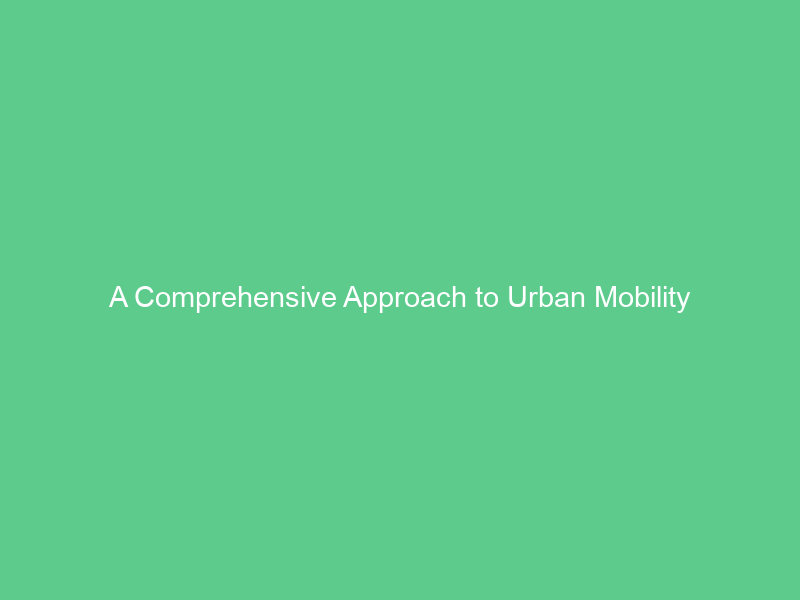Urban mobility is a crucial issue affecting economic and social sustainability, necessitating an integrated solution.
Attracting millions of trips away from motorized private transport and onto more environmentally sustainable modes presents an enormous challenge, yet proven solutions exist for doing this successfully. Step one in this endeavor should be conducting an in-depth evaluation of current mobility conditions within a city’s borders.
Cars
Urban mobility refers to the movement of people and goods within cities by public transit or private vehicles. Motorization and the spread of automobiles caused significant declines in public transit ridership during the second half of the 20th century and led to changes at social, economic and morphological levels.
Cars have long been symbols of status, autonomy and comfort – yet at the same time are responsible for noise pollution and air quality issues. Furthermore, their use leads to sprawl in cities and limits space allocated for public transit operations.
Minimobility vehicles such as e-scooters or e-bikes provide flexible, cost-effective, and environmentally friendly short trips in cities. Vehicle-sharing platforms can integrate them to reduce individual transport needs; their use may vary according to geography and climatic conditions.
Buses
Buses are one of the most widely utilized forms of public transport in cities. Their versatility enables them to serve diverse urban regions across an economy while their operation remains cost-efficient.
Personal mobility during the latter half of the 20th century, coupled with highway construction, had a profound effect on lifestyle patterns and residential locations, leading to an increasing number of people living in peripheral locations that lacked central services. Furthermore, limited public transit options and costly automobile ownership limited certain groups’ access to goods and services.
To address these challenges, the European Commission introduced its Sustainable Urban Mobility Plans (SUMP) concept and encouraged cities to draft their own sustainable urban mobility plans (SUMPs). According to this concept, cities and their commuting zones should be treated as whole functional units, taking into account real traffic flows.
Taxis
Taxis remain an integral component of urban mobility despite challenges like driver shortage and ride-hailing services, playing an essential role in providing eco-friendly vehicles and relieving congestion to improve air quality and lower energy usage.
NYC taxi drivers have an obligation to transport you safely to your destination, so the best approach is to state clearly where your journey should take place and ensure your driver knows. Furthermore, make a note of their name as well as asking for an estimated fare estimate before entering their vehicle.
Multimodal mobility systems that offer cabs, ridehailing services, buses, trains and cars through one app will revolutionise how people get around cities. It puts the needs of individual commuters first while encouraging more carpoolers.
Ride Sharing
As more people move toward cities, it’s increasingly essential that these environments become as liveable as possible. That means designing and operating urban mobility systems that are cleaner, safer, more efficient and accessible.
Ride sharing services connect individual drivers and passengers through mobile applications to meet supply and demand for rides more effectively, leading to shorter wait times for riders and better utilization for drivers.
Ride sharing apps should enable ratings and reviews from both drivers and passengers, giving users a full picture of a driver’s skills and attitude. This can help users avoid dangerous drivers while increasing safety – it also benefits older adults who become more isolated as they no longer drive or take public transit.
Bicycles
Human creativity has long made the bicycle an affordable and reliable means of transportation, serving as an icon for two centuries as an affordable solution for travel. Once known as hobby horses, boneshakers or velocipedes, bikes have long been used by people of all ages and abilities – helping promote physical activity while simultaneously decreasing stress levels.
Bicycles do not emit pollution and have been shown to reduce congestion, air and noise pollution, greenhouse gas emissions and carbon footprint – creating a sustainable city that is climate friendly. Reaching these goals requires investment from local government, community members and businesses coming together in partnerships.
E-bikes make cycling more accessible to a broader range of urban residents, including those with limited physical abilities. Furthermore, they enable short trips too short to warrant using a car and cargo e-bikes allow deliveries to be efficiently made.

